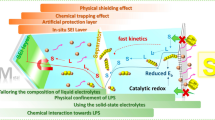Abstract
A stable polyradical, poly (2,2,6,6-tetramethylpiperidinyloxy methacrylate)(PTMA), was synthesized, and its structure was determined by infrared, ultraviolet-visible, and ESR spectroscopy. Cyclic voltammograms of the PTMA polyradical electrodes were obtained by using a three-electrode cell at a scan rate of 5 mV/s within a potential range of 3.2–4.0 V. The results show that the shape of oxidation peak is very similar to that of reduction peak, and oxidation peak current is equal to the corresponding reduction peak current, which suggest that PTMA possesses an excellent reversibility. The difference of the anodic peak potential (E a,p=3.66 V, vs Li/Li+) and cathodic peak potential(E c,p=3.58 V, vs Li/Li+) is estimated at 80 mV, which is extremely less than that of the other organic positive materials in lithium second batteries such as organosulfide compounds, leading to a capability for high current capability in the charging and discharging process of the battery. The maximum discharge specific capacity of PTMA is 78.4 mA · h/g at the constant discharge current of 0.3 mA (0.2 C rate), the coulombic efficiency is about 95%, and the charging and discharging curves of the batteries have an obvious plateau at 3.65 V and 3.56 V, respectively. The discharging specific capacity of the battery decreased is about 2% after 100 cycles. The PTMA/Li button batteries exhibite an excellent stability.
Similar content being viewed by others
References
Krzyczmonik P, Scholl H. Electrode reactions of nitroxide radicals Part 10. kinetics and mechanisms of the redox reactions of the 2,2,6,6-tetramethylpiperdine-1-oxyl derivatives in acetonitrile solutions on the gold electrode. Experiment and simulation analysis [J]. J Electroanal Chem, 1992,335:233–251.
Park S G, Aoki K, Tokuda K, et al. Electrochemical behavior of nitroxy radical monolayers prepared on tin oxide electrodes by the langmuir-blodgett method[J]. J Electroanal Chem, 1985,195: 157–163.
Nakahara K, Iwasa S, Satoh M, et al. Rechargeable batteries with organic radical cathodes[J]. Chemical Physics Letters, 2002, 359: 351–354.
WANG Yu-kun. Synthesis of light stabilizers of several kinds of polymers [J]. Journal of Xiao Petro Inst Mar(in Chinese), 1997, 12 (2): 47–49.
ZHANG Zhi-yi. Preparation of 2,2,6,6-tetramethyl-4-hydro-piperdine-1-oxyl[J]. Journal of Lanzhou University (Natural Science)(in Chinese), 1980, 2: 112–113.
ZHANG Zhi-yi, LIU Zhao-rong. Inhibiting properties of 2,2,6,6-tetramethyl-4-oxo-piperdine-1-oxyl and its synergistic action with quinines [J]. Gaofeizi Tongxun(in Chinese), 1980, 3:182–185.
Kurosaki T, Takahashi O, Okawara M. Polymers having stable radicals II Synthesis of nitroxyl polymers from 4-methacryloxyl derivatives of 1-hydroxy-2,2,6,6-tetramethylpiperdine[J]. Journal of Polymer Science: Polymer Chemistry Edition, 1974,12: 1407–1420.
Cohen A H, Hoffman B M. Nitrogen-14 and oxygen-17 hyperfine interactions in perturbed nitroxides[J]. Journal of Physical Chemistry, 1974, 78(13): 1313–1321.
Author information
Authors and Affiliations
Corresponding author
Rights and permissions
About this article
Cite this article
Deng, Lf., Li, Xh., Xiao, Lx. et al. Synthesis and electrochemical properties of polyradical cathode material for lithium second batteries. J Cent. South Univ. Technol. 10, 190–194 (2003). https://doi.org/10.1007/s11771-003-0006-x
Received:
Accepted:
Issue Date:
DOI: https://doi.org/10.1007/s11771-003-0006-x




